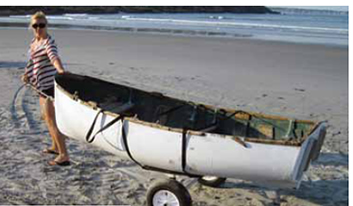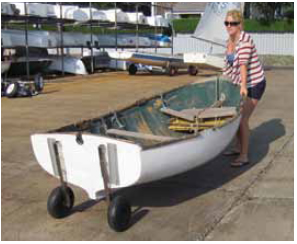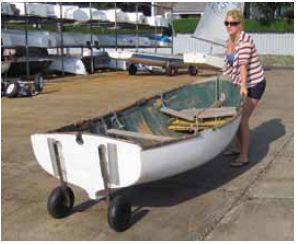
353

297
We tested each product for overall quality of construction, ease of installation, and ease of use. Each model was tested on three different surfaces that are common dinghy-transporting areas: an inclined, concrete boat launch ramp with cracks in the pavement wide enough to push some dinghy dollies off course; a sandy beach, where the sand ranged from nearly flat and hard at water’s edge to more than 4 inches deep and soft above the high-tide mark; and a rocky shoreline, with some irregular stones that measured up to a foot in diameter. Each set of dinghy wheels was attached to the transom of a 9-foot, 130-pound rowing skiff. To avoid drilling a bunch of holes in our own $1,200 dinghy, we picked up a haggard—but appropriately sized—$75 garage-sale skiff for these tests.
For the first test, the skiff was rolled 50 feet down the sloped boat ramp and into the water, then pushed uphill back to the starting point. It was here that testers encountered the value of having launching wheels in the down position with the dinghy upright. It meant we could push the dinghy straight into the water instead of having to flip it over.
Once the boat was in the water, we discovered how easily cotter, clevis, and lock pins could be lost overboard. Most of the test products required removing a pin before lifting the strut and wheel out of the water and fitting it into the upright position; reinserting the pins was necessary to hold the strut in place. The Davis small-boat dolly and the Defender and Danard designs offered other methods of storing the wheels for getting underway.
All of the test products rated Excellent for performance on the flat cement surface At the rocky shore, each set of dinghy wheels was rolled across 30 feet of shoreline to the water’s edge and back to the starting point. The rocks were mostly softball size or larger, not gravel, and proved to be the biggest challenge for most of the test wheels. Lastly, each setup was rolled across 50 feet of soft sand. In every instance, the dinghy wheels with inflatable tires outperformed those with smaller, molded plastic tires.
We did not rate the models for ease of assembly because five of seven required tools to attach the brackets to the dinghy transom, and these five were about the same in that respect. It was important to note that when attaching the brackets, a dinghy owner should take into consideration where an outboard engine might occupy space. It was equally important that when mounting the struts, the wheels protrude far enough beyond the dinghy’s keel to roll unimpeded on the various terrains.




































